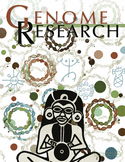New advances in sequence assembly
- National Human Genome Research Institute, National Institutes of Health, Bethesda, Maryland 20892, USA
- Corresponding author: adam.phillippy{at}nih.gov
This extract was created in the absence of an abstract.
It may be hard to believe, but the idea of sequence assembly is around 40 years old. Consider this pair of quotes from Rodger
Staden (Staden 1979):
“With modern fast sequencing techniques and suitable computer programs it is now possible to sequence whole genomes without
the need of restriction maps.”
“If the 5′ end of the sequence from one gel reading is the same as the 3′ end of the sequence from another the data is said
to overlap. If the overlap is of sufficient length to distinguish it from being a repeat in the sequence the two sequences
must be contiguous. The data from the two gel readings can then be joined to form one longer continuous sequence.”
Replace “gel reading” with “read” and these sentences would go unnoticed in the introduction of any paper today. Here you can also see the birth of jargon that now pervades the field: overlaps between reads form contigs (contiguous sequences). Just a few months later, Gingeras et al. (1979) described “Computer programs for the assembly of DNA sequences.” It all sounds so modern, until the discussion mentions FORTRAN code stored on magnetic tapes.
How, then, can we fill an entire special issue of Genome Research with “new advances” so many years later? To me, this reflects the beauty of the problem—simple enough to be stated in a single paragraph, yet complex enough to sustain a field of research for decades. This dichotomy is common to many famous computational problems; indeed, mathematical formulations of sequence assembly fall into a class of problems known as “NP-hard” that do not admit an easy solution (Medvedev et al. 2007).
There is another reason for continued advances in sequence assembly—advances in sequencing technology. As evident from the Staden quotes above, the first assembly methods were …











